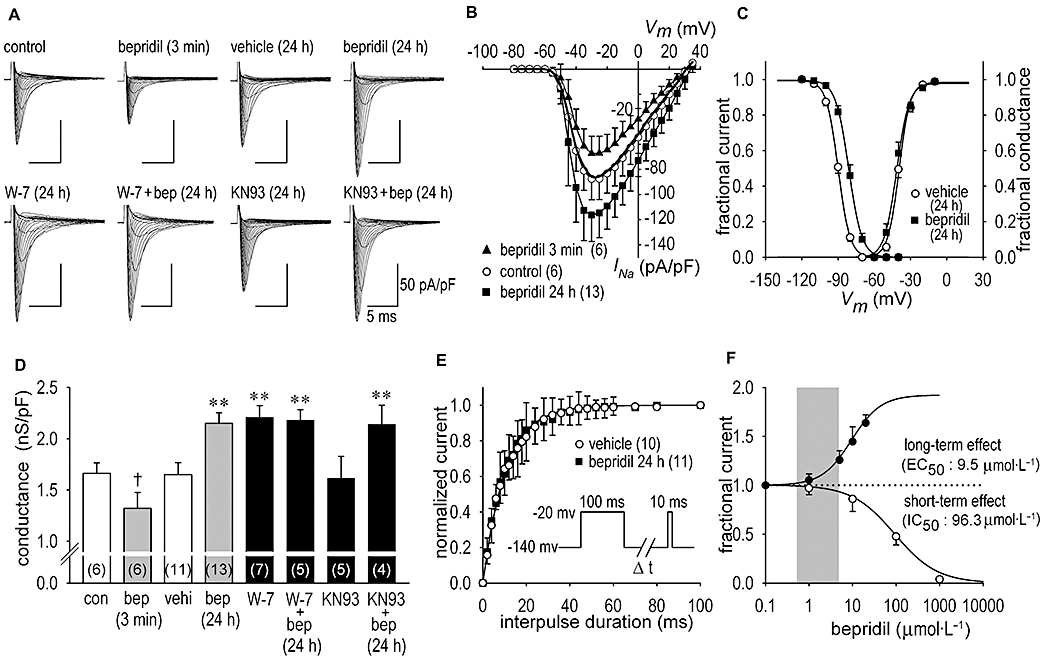Figure 1.

Short- and long-term effects of bepridil on Na+ channel current (INa) in neonatal rat cardiomyocytes. (A) Representative INa families in the control condition and during the acute (3 min) application of 10 µmol·L−1 bepridil given to the same patch are shown. Also, representative INa families after the long-term (24 h) treatment with vehicle (saline), 10 µmol·L−1 bepridil, 20 µmol·L−1 W-7, 20 µmol·L−1 W-7 with 10 µmol·L−1 bepridil (bep), 10 µmol·L−1 KN93 [2-[N-(2-hydroxyethyl)-N-(4-methoxy benzenesulphonyl)]-amino-N-(4-chlorocinnamyl)-N-methylbenzylamine, a Ca2+/calmodulin -dependent kinase inhibitor] and 10 µmol·L−1 KN93 with 10 µmol·L−1 bepridil are shown respectively. INa was elicited by a depolarization pulse of 35 ms duration, ranging from −80 to 30 mV in 5 mV steps, applied from the holding potential of −140 mV. During INa recordings, bepridil was excluded from the bath solution, except for the short-term application of bepridil. (B) I–V relationships constructed by using group data in control during the application of 10 µmol·L−1 bepridil in 3 min and after long-term treatment of 10 µmol·L−1 bepridil for 24 h. I–V relationship in the vehicle treatment for 24 h is shown in bold solid line without symbol for clarity. (C) The steady-state activation and inactivation curves of the Na+ channel obtained from cardiomyocytes treated with bepridil for 24 h. Mid-points of the voltage relation for the activation (Va, 1/2) and slope factors (k) were −39.9 ± 0.8 mV and −4.5 ± 0.6 (n = 11) in vehicle and −41.7 ± 0.6 mV and −4.9 ± 0.6 (n = 13) after treatment with bepridil for 24 h respectively. For inactivation, the Vi, 1/2 values and slope factors (k) were −89.8 ± 2.0 mV and 4.8 ± 0.3 (n = 10) in vehicle and −81.2 ± 2.5 mV and 5.4 ± 0.4 (n = 11) after treatment with bepridil for 24 h respectively. Curves were fitted by the Boltzmann equation (see Methods section). (D) The maximum chord conductance in the control condition (con), during acute (3 min) application of bepridil (bep), in vehicle (vehi) for 24 h, after the long-term (24 h) action of 10 µmol·L−1 bepridil, after the long-term action of 20 µmol·L−1 W-7 in the absence and presence of 10 µmol·L−1 bepridil and after the long-term action of 10 µmol·L−1 KN93 in the absence and presence of 10 µmol·L−1 bepridil. Numbers of experiments are shown in parentheses. (E) Time course of recovery from inactivation of INa. Curves were fitted to the data by using a single exponential equation yielding time constant (τ) of 10.5 ± 0.2 ms (n = 10) in vehicle and 10.8 ± 0.2 ms (n = 11) after treatment with bepridil for 24 h. Pulse protocols are shown in inset. (F) Concentration-dependent short-term (3–20 min) and long-term (24 h) effects of bepridil on INa elicited at the frequency of 0.1 Hz at −30 mV. The short-term inhibition and long-term increase of INa was plotted against the bepridil concentration. The short-term IC50 value for INa was estimated to be 96.3 µmol·L−1, whereas the long-term EC50 value for INa was estimated to be 9.5 µmol·L−1. The grey area indicates effective plasma concentration (0.5–5 µmol·L−1). †P < 0.05 compared with control, **P < 0.01 compared with vehicle.
